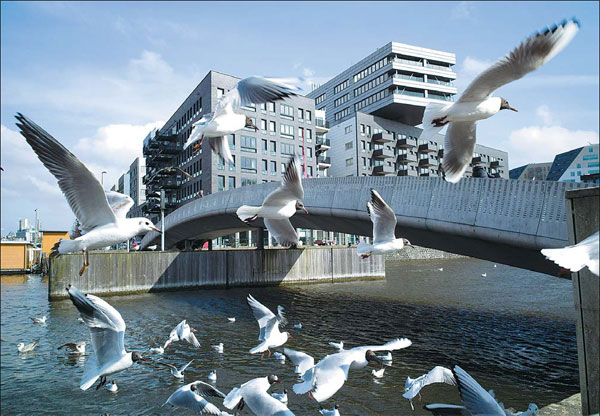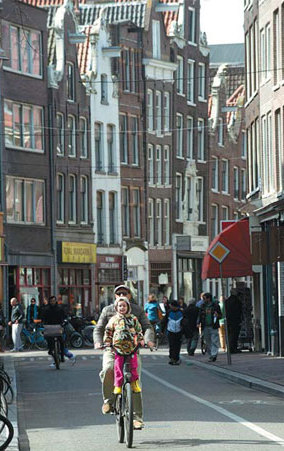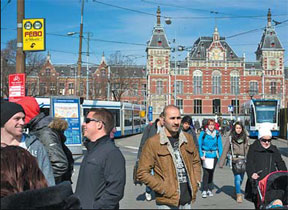Time to reflect
Updated: 2013-06-09 05:50
By Russell Shorto(The New York Times)
|
|||||||
|
New housing on Westerdok, a man-made island built in 19th-century Amsterdam. Photos provided to China Daily |
Amsterdam is a city rich in history and short on space. Russell Shorto revels in the quaint charms of the capital of the Netherlands.
The Haarlemmerstraat in Amsterdam is a narrow enough thoroughfare that from my office window I can easily see into the shops across the street. There is the olive oil boutique, with its rows of metal barrels and its sign inside saying, "Check Your Oil," and the coffee shop that young, nattily dressed tourists wander into to get licitly high. Looking up, I have to crane my neck to take in the succession of gable types on the brick facades - step, bell, spout - that signal the changing fashions among real estate developers during the city's golden age in the 17th century.
The Haarlemmerstraat is hardly unique. In a city that was essentially carved out of peat bogs, space has always been at a premium. Curiously, the earlier occupants of the building where I work (a few centuries earlier) had all the room in the world.
|
Cyclists and pedestrians enjoys a sunny day on Haarlemmerstraat. |
The building is called the West India House. In the 1600s the directors of the Dutch West India Company ran a business from here that extended to the Caribbean, South America and North America, and whose products included salt, timber, tar, sugar and slaves.
From this building they set up overseas outposts, one of which, New Amsterdam, they located at the southern tip of Manhattan Island. I like to think of their meeting room, across the courtyard from my office, as the place where New York City was conceived.
I work in the West India House which houses an American culture center called the John Adams Institute, which, when it was founded 25 years ago, was located here because of the building's historic connection to America.
In the seven years I've lived in Amsterdam, I often find myself pondering the concept of space. For all the vastness of the world the Dutch once lorded over, they have restricted themselves to this small patch of it, a patch that remains cramped and ever threatened by water.
You could pick a neighborhood of the city at random, and you'd find that it would illustrate these two things: How Amsterdam has always reached outward, and how its inhabitants are constantly, often ingeniously, rebuilding, reinventing, repurposing their little corner of the Earth.
Take for example my lunchtime walk. If I turn right on the Haarlemmerstraat, I pass an ethnic stew of restaurants - Chinese, Thai, French, Argentine - and come out onto a little plein (square) where I sometimes get lunch at a herring kiosk.
Traditional Dutch herring is raw and lightly preserved in brine and served on a roll with onions and sweet pickles. It harkens back to the city's first age of expansion, when in the 1500s its ships gained mastery of the North Sea fisheries.
A few steps north take you to the edge of the harbor, which was once fabled for its "forest of masts," a turn of phrase that suggests both the city's global reach back then and the fact that in its golden age Amsterdam's urban infrastructure actually extended out onto the water.
The body of water has a curious Dutch name: it's called the IJ; the syllable is pronounced something like "eye," and the pearly white building directly on the opposite shore, with a roofline that gives it the look of an opening eye, is the new EYE Film Museum, part of the city's effort to repurpose the waterfront and, with its constantly rotating calendar of films from around the world, an indication that Amsterdam's focus is still out there.
Were you to walk east from here you'd arrive at Central Station, the city's rail hub. But unless I'm actually taking a train I avoid that chaos.
Instead, heading west brings me to a stretch of stylish new apartment buildings extending straight out into the IJ, each with its own quayside lined with pleasure boats.
This arm of land is a man-made island, called Westerdok, built in the 19th century to accommodate Central Station.
|
Central Station is the city's rail hub. |
The island was created as a kind of parking lot for trains. That was no longer necessary by the late 20th century, whereupon it was reinvented as a neighborhood.
Next to Westerdok is a cluster of three more artificial islands whose distinct character derives from the fact that they were created in the 17th century.
In the process of digging the canals that make up what is today Amsterdam's most distinguishing topographical feature, the city planners of the golden age found they had a lot of extra dirt. They solved that problem by using it to create more living space in the harbor.
Crossing a little bridge onto Prinseneiland, the prettiest of the three, is one of my favorite things to do in the city, for even though you're still in Amsterdam, you get an instantaneous feeling of having stepped into a 17th-century fishing village.
Little wooden drawbridges connect these three islands. In nice weather I'll bring my broodje haring (herring sandwich) to a bench here and contemplate the big old sailing ships and barges anchored at the inlets.
Back on the mainland, I swing up onto the Haarlemmerstraat again (actually, it changes name midway, and here is called the Haarlemmerdijk). Thirty years ago this was one of the city's rougher neighborhoods, but a public-private initiative revitalized it so that it is now a hip shopping street.
Here and there the line of old brick facades is broken by 1980s-era buildings that just don't fit their surroundings.
Behind the tiny shops of the Haarlemmerdijk are quiet complexes of town houses and apartment buildings, sculptured around pretty little gardens. Tulips were just coming up. The idea in the 1980s was the same as in the 17th century: Find new ways to maximize the space.
Of course, space is at a premium in cities everywhere. But few places have the constraints of Dutch cities.
The buildings along the Haarlemmerstraat highlight one of the challenges that have always faced residents. Postcards of Amsterdam canal houses showcase their photogenic tilt.
But the tilt isn't there for charm; it's an indication of seriously unstable subsoil. You can't build very high in Amsterdam, and even three stories may result in structural shifting to the point that a house's foundation has to be redone.
Heading back to my office brings me to the place where the street crosses over the Prinsengracht, one of the main canals that define the city center.
The old locks that dominate this spot where the canal grid meets the harbor underscore the point that while, like the tilting houses, the canals are seen today through the prism of quaintness, they were built out of necessity. In a country where much of the land is below sea level, managing water flow was and remains a basic element of survival.
Walking Amsterdam is, among many other things, an atmospheric object lesson in how humans solve problems that they themselves created.
The New York Times
(China Daily 06/09/2013 page16)


